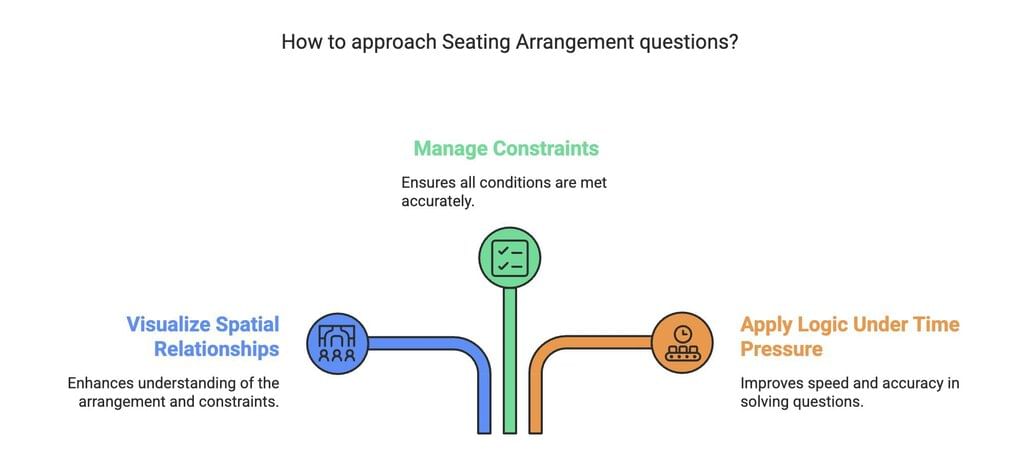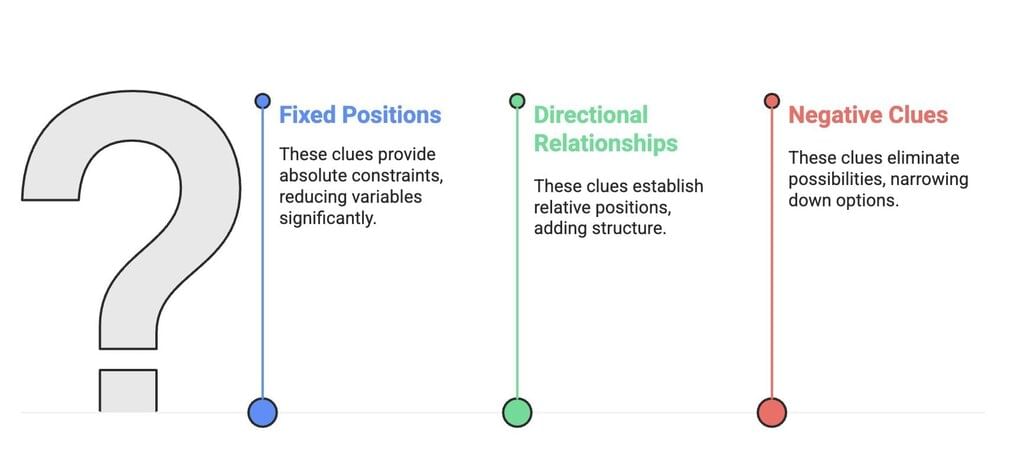5 Golden Rules for Seating Arrangements | Logical Reasoning (LR) and Data Interpretation (DI) - CAT PDF Download
Seating Arrangement questions are a cornerstone of the Logical Reasoning and Data Interpretation (LRDI) section in the CAT exam. These questions test your ability to visualise spatial relationships, manage constraints, and apply logic under time pressure. Below are specific, actionable rules derived from expert strategies and past CAT patterns to help you master this topic.

Key Concepts to Master First
Types of Arrangements :
- Linear: People seated in a straight line (e.g., row of chairs).
- Circular: People seated around a round table (facing inward/outward).
- Square/Rectangular: People seated at corners or along edges.
- Complex: Combines multiple rows/columns or adds attributes (e.g., professions, directions).
Terminology :
- Adjacent: Next to each other (immediate left/right).
- Opposite: Directly across (e.g., in a square table, positions 1 and 3 are opposite).
- Facing Direction: Critical in circular/square arrangements (e.g., A faces North, B faces South).
Golden Rule 1: Visualise First, Write Later
Never start solving without sketching.
Why it matters: Seating arrangements are spatial puzzles. A rough diagram helps track positions, gaps, and overlaps.
Pro Tip: Use symbols for relationships:
"A ↔ B" = A and B sit together.
"A | B" = A and B are separated by one seat.
"A ≠ Left/Right" = Directional constraints.
- For circular arrangements, fix a reference point (e.g., mark the north position).
Golden Rule 2: Prioritise "Fixed" Clues
Start with absolute constraints to anchor your diagram.
Why it matters: Clues like "X sits third to the left" or "Y is at the corner" reduce variables.
Pro Tip: Rank clues by restrictiveness:
Fixed positions (e.g., "A sits at Position 3").
Directional relationships (e.g., "B is to the immediate left of C").
Negative clues (e.g., "D does not sit next to E").
Golden Rule 3: Use Elimination Tables for Hybrid Puzzles
When professions/ages/floors are involved, track them separately.
Why it matters: Hybrid questions (e.g., "Arrange people by height and profession") require multi-layered tracking.
Pro Tip: Create a dual-axis table

Golden Rule 4: Decode "Could Be" and "Must Be" Questions Differently
Rule: "Could Be" = Test options; "Must Be" = Derive logically.
Why it matters: CAT often asks, "Which of the following must be true?" vs. "Which could be false?"
Pro Tip:
For "Must Be": Eliminate options that violate all possible scenarios.
For "Could Be": Find at least one valid scenario supporting the option.
Golden Rule 5: Understand Directional Clues
Circular/Square Arrangements :
- "To the left/right" depends on the facing direction.
- If everyone faces inward:
- Left = Counter-clockwise
- Right = Clockwise
- If mixed directions: Assign directions first before solving.
- Linear Arrangements: Always clarify whether the line is horizontal or vertical.
Step-by-Step Strategy for Tackling Questions
- Read All Clues First: Underline critical constraints (e.g., fixed positions, prohibitions).
- Identify Fixed Points: Start with clues that fix someone’s position (e.g., "X sits at the extreme right").
- Build the Base Structure: Sketch a rough diagram with fixed positions.
- Add Adjacent/Relative Clues: Fill in neighbours based on adjacency rules.
- Test for Contradictions: Eliminate invalid options early.
- Finalise the Arrangement: Cross-verify all clues.
Common Mistakes to Avoid
- Mixing Up Left/Right in Circular Arrangements: Always align with the facing direction.
- Assuming Fixed Positions Without Evidence: Wait for a concrete clue before fixing someone’s seat.
- Ignoring Hidden Constraints: E.g., "No one sits between P and Q" implies they are adjacent.
- Overcomplicating Diagrams: Keep sketches minimal and focused on key relationships.
|
77 videos|180 docs|96 tests
|
FAQs on 5 Golden Rules for Seating Arrangements - Logical Reasoning (LR) and Data Interpretation (DI) - CAT
| 1. What are the key concepts to master for seating arrangements in the CAT exam? |  |
| 2. What is a step-by-step strategy for tackling seating arrangement questions in CAT? |  |
| 3. What common mistakes should I avoid when solving seating arrangement problems? |  |
| 4. Are there any golden rules for solving seating arrangement problems effectively? |  |
| 5. How can I improve my seating arrangement skills for the CAT exam? |  |





















